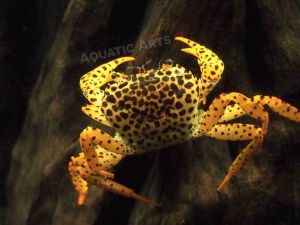
Panther Crab (Parathelphusa pantherina) are fully aquatic crabs that originates from Indonesia

photo credit: Aquatic Arts
Panther Crabs, or Parathelphusa panthernia to use their scientific name, are aquatic crabs that have been spotted in Indonesia. As one of the few crabs that can be kept in a freshwater aquarium while remaining completely submerged at all times, they are an excellent choice. This crab could replace crayfish in recipes thanks to its mild demeanor. They also lack the huge claws of other crabs, such as the fiddler crab.
Panther Crabs can range from a vibrant orange to a muted brown, with black dots that are larger on the body and smaller on the legs. This crab, with its flashy patterns and boundless energy, will keep you amused for hours.
We release them between 1 and 3 inches long, despite the fact that full-grown adults can reach a diameter of 5 inches (legs and claws included) (their bodies alone grow to about 3 inches in diameter). The Panther Crab family includes numerous species, each with its own unique personality and bright orange coloration. Despite spending a lot of time underground, they are very active. It is normal for these crabs to be shy at first, but as they adjust to their new home they will become more daring. Look no further than this crab if you want something truly special for your fish tank!
Panther Crabs are social creatures, so it's possible to keep them with others of their own kind. They require little in the way of upkeep and are surprisingly sturdy. Nonetheless, these crabs are opportunistic predators and may choose to feast on dwarf shrimp or tiny snails (which may be a good thing if the snails are unwanted!). Due to the size of their tiny claws, only bottom-dwelling fish need worry.
References
Panther Crab (Parathelphusa pantherina) are fully aquatic crabs that originates from IndonesiaPom Pom Crab (Ptychognathus barbatus) a true gem and consummate nano aquarium specimen!
Thai Micro Crabs (Limnopilos naiyanetri) tiny, fully aquatic crabs that so far have only been found in one specific river in Thailand